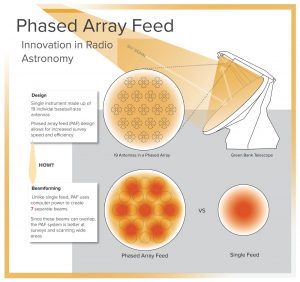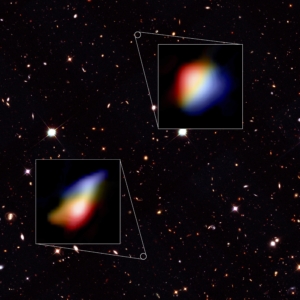Zooming in to the galaxies discovered by ALMA that are evolving into a galaxy cluster. The outer field is from data taken by the Hershel Space Observatory. The middle image — a portion of a much-wider survey by NSF’s South Pole Telescope — uncovered the distant galactic source that was studied by ALMA to reveal the 14 galaxies.


Innovation Advances ‘Phased Array Feed’ Imaging System
Infographic demonstrating the layout of the newly designed Phased Array Feed receiver that was tested on the Green Bank Telescope.

Powerful Flare from Star Proxima Centauri Detected with ALMA
Artist impression of a red dwarf star like Proxima Centauri, the nearest star to our sun. New analysis of ALMA observations reveal that Proxima Centauri emitted a powerful flare that would have created inhospitable conditions for planets in that system.

Stellar Embryos in Nearby Dwarf Galaxy Contain Surprisingly Complex Organic Molecules
Astronomers using ALMA have uncovered chemical “fingerprints” of methanol, dimethyl ether, and methyl formate in the Large Magellanic Cloud. The latter two molecules are the largest organic molecules ever conclusively detected outside the Milky Way. The far-infrared image on the left shows the full galaxy. The zoom-in image shows the star-forming region observed by ALMA. It is a combination of mid-infrared data from Spitzer and visible (H-alpha) data from the Blanco 4-meter telescope.

GBT Finds Benzonitrile in the Taurus Molecular Cloud 1
Astronomers using the Green Bank Telescope have made the first definitive interstellar detection of benzonitrile, an intriguing organic molecule that helps to chemically link simple carbon-based molecules and truly massive ones known as polycyclic aromatic hydrocarbons. This discovery is a vital clue in a 30-year-old mystery: identifying the source of a faint infrared glow that permeates the Milky Way and other galaxies. The science team, led by chemist Brett McGuire at the National Radio Astronomy Observatory in Charlottesville, Virginia, detected this molecule’s telltale radio signature coming from a nearby star-forming nebula known as the Taurus Molecular Cloud 1, which is about 430 light-years from Earth.

Astronomers Detect Whirlpool Movement in Early Galaxies
ALMA images of rotating galaxies in the early universe shown on a background from the Hubble Space Telescope.





